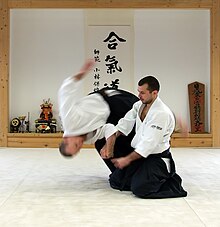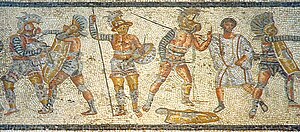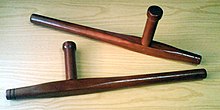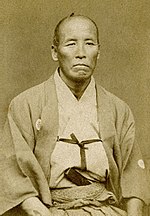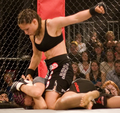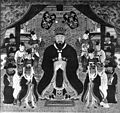
Back بوابة:فنون قتالية Arabic প্রবেশদ্বার:মার্শাল আর্ট Bengali/Bangla Portal:Kampfkunst German Portal:Artes Marciales Spanish Portail:Arts martiaux et sports de combat French Портал:Жекпе-жек Kazakh Portal:Artes marciais Portuguese Портал:Боевые искусства Russian Portal:武術 Chinese
The Martial Arts Portal

Martial arts are codified systems and traditions of combat practiced for a number of reasons such as self-defence; military and law enforcement applications; competition; physical, mental, and spiritual development; entertainment; and the preservation of a nation's intangible cultural heritage. (Full article...)
Although the earliest evidence of martial arts goes back millennia, the true roots are difficult to reconstruct. Inherent patterns of human aggression which inspire practice of mock combat (in particular wrestling) and optimization of serious close combat as cultural universals are doubtlessly inherited from the pre-human stage and were made into an "art" from the earliest emergence of that concept. Indeed, many universals of martial art are fixed by the specifics of human physiology and not dependent on a specific tradition or era.
Specific martial traditions become identifiable in Classical Antiquity, with disciplines such as shuai jiao, Greek wrestling or those described in the Indian epics or the Spring and Autumn Annals of China. (Full article...)
Selected articles
Selected biography
After the fall of the Tokugawa shogunate Sakakibara was instrumental in preserving traditional Japanese sword techniques in the early Meiji Era. Despite his eventual opposition to the practice of sword fighting for sport, his work during this period laid the foundations for the modern sport of kendo. In his later years he taught a number of noted martial artists, and was honoured by the All Japan Kendo Federation after his death. (Full article...)
Selected entertainment
Rocky Balboa is a 2006 American sports drama film written, directed by, and starring Sylvester Stallone. It is the sequel to Rocky V (1990) and the sixth installment in the Rocky film series. It also stars Burt Young and Antonio Tarver in his only acting role. In the film, Rocky Balboa (Stallone), now an aging small restaurant owner, is challenged to an exhibition fight by hothead young boxer Mason Dixon (Tarver).
Development for a sixth Rocky film began after Stallone expressed regret of the outcome of Rocky V, which was viewed as a disappointing conclusion to the end of the franchise. Rocky Balboa includes references to characters and objects from previous installments, and Stallone was inspired by recent personal struggles and triumphs when writing the film. It is Stallone's first directorial effort since Rocky IV (1985) and is Tarver's only feature film appearance. Principal photography began in December 2005 and lasted until January 2006, with filming locations including Las Vegas, Los Angeles, and Philadelphia. In contrast to previous entries in the franchise, the fight choreography in Rocky Balboa was less scripted, featuring real punches thrown by Stallone and Tarver.
Rocky Balboa was theatrically released by MGM Distribution Co. in North America and 20th Century Fox internationally on December 20, 2006, thirty years after the release of the first film. Rocky Balboa received generally positive reviews from critics, with praise for its screenplay, Stallone's performance, and heartfelt exploration of Balboa's character, with many critics calling it a significant improvement over its predecessor, and many labelling the film one of the best entries in the franchise. It grossed over $156 million worldwide, surpassing expectations to rebound from the box office performance of its predecessor. A spin-off, Creed, was released in 2015 and kickstarted its own series, while a seventh mainline Rocky film is in development.
Sports portals
Selected image
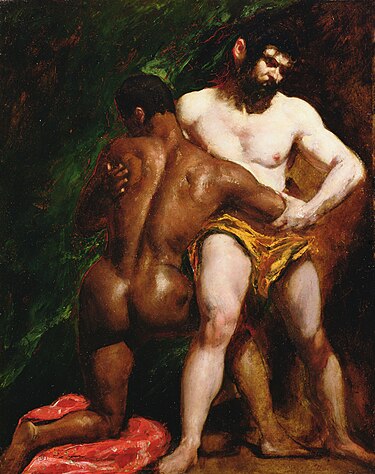 |
The Wrestlers is an oil painting on millboard by English artist William Etty, painted around 1840 and currently in the York Art Gallery, in York, England. It depicts a wrestling match between a black man and a white man, both glistening with sweat and under an intense light emphasising their curves and musculature. While little documentation of the painting exists prior to 1947, it is likely that it was painted over a period of three evenings at the life class of the Royal Academy. (Full article...)
General images -
Selected quote
Topics
- Regional origin - China - Europe - India - Indonesia - Japan - Korea - Philippines
- Unarmed techniques - Chokehold - Clinch - Footwork - Elbow strike - Headbutt - Hold - Kick - Knee strike - Joint lock - Punch - Sweep - Takedown - Throw
- Weapons - Archery - Duel - Knife fighting - Melee weapons - Shooting - Stick-fighting - Swordsmanship
- Training - Kata - Practice weapon - Punching bag - Pushing hands - Randori - Sparring
- Striking - Boxing - Capoeira - Karate - Kickboxing - Muay Thai - Lethwei - Sanshou - Savate - Taekwondo - Vovinam
- Internal - Aikido - Aikijutsu - Baguazhang - Tai chi - Xing Yi Quan
- Full contact / Combat sports - Professional boxing - Professional kickboxing - Knockdown karate - Mixed martial arts - Pankration - Submission wrestling
- Self-defense / Combatives - Arnis - Bartitsu - Hapkido - Kajukenbo - Krav Maga - MCMAP - Pencak Silat - Systema - Wing Chun - Legal aspects
- Eclectic / Hybrids - American Kenpo - Chun Kuk Do - Jeet Kune Do - Shooto - Shorinji Kempo - Unifight
Categories
Things you can do
See the list on the right of Martial art related projects who organise work on these articles. You can also add your self to the list of Wikipedians by martial art
Talk page tagging
If you come across a martial arts related article, adding the project template {{WikiProject Martial arts}} to the talk page will help identify them for improvement and linking to related articles. For Boxing, Fencing, Mixed martial arts and Sumo. Use {{WikiProject Boxing}}, {{WikiProject Fencing}}, {{WikiProject Mixed martial arts}} and {{WikiProject Sumo}} respectively.
- Assessment
- If possible please assess articles you tag using guidelines (Boxing, Mixed martial arts and Sumo).
Deletions
Monitor and contribute to deletion debates (Boxing).
Find images
Wikipedia requested images of martial artists, mixed martial artists and boxers.
Associated Wikimedia
The following Wikimedia Foundation sister projects provide more on this subject:
-
Commons
Free media repository -
Wikibooks
Free textbooks and manuals -
Wikidata
Free knowledge base -
Wikinews
Free-content news -
Wikiquote
Collection of quotations -
Wikisource
Free-content library -
Wikiversity
Free learning tools -
Wikivoyage
Free travel guide -
Wiktionary
Dictionary and thesaurus


